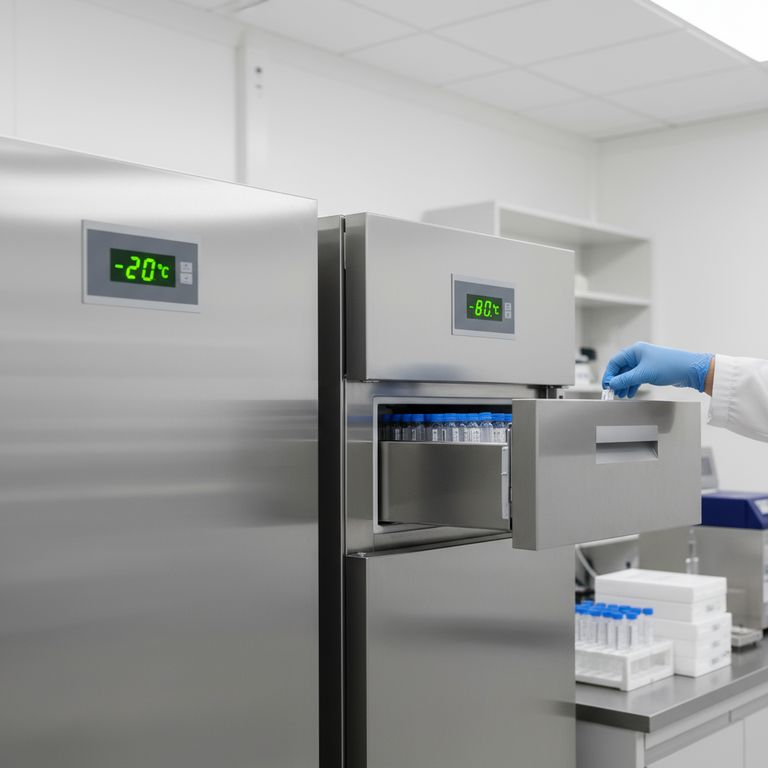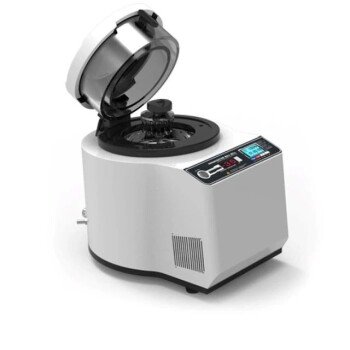For long-term sample integrity, both -20°C and -80°C are effective for storing genomic DNA, but they serve different purposes based on the intended storage duration and sample value. While a standard -20°C freezer is adequate for routine storage over months to a few years, an ultra-low -80°C freezer is the gold standard for archival preservation, ensuring sample stability for decades.
The choice between -20°C and -80°C is fundamentally a decision about time. Your goal is to halt the molecular activity that degrades DNA, and -80°C accomplishes this far more completely, making it the only appropriate choice for irreplaceable, long-term sample archiving.

The Core Principle: Halting Degradation
To understand the difference, you must first understand the primary threats to a DNA sample: enzymatic activity and chemical breakdown. Lowering the temperature is our most powerful tool against both.
Why Temperature Is Critical
DNA is a highly stable molecule, but it is not inert. At room temperature or even 4°C, several processes can begin to break it down over time. Freezing a sample essentially pauses these destructive processes.
The Primary Threat: Nucleases
The most immediate danger to DNA is from DNases—enzymes that cut DNA strands. These can be introduced as contaminants during purification or be present endogenously in the sample. While freezing slows them down, only ultra-low temperatures effectively bring their activity to a complete standstill.
The Slow Threat: Chemical Hydrolysis
Over very long time scales (years to decades), DNA can also be damaged by slow chemical reactions like depurination, where a base is lost from the sugar-phosphate backbone. This process is accelerated by acidic conditions and the presence of water. Freezing the water in the sample dramatically slows this process.
Comparing -20°C vs. -80°C Storage
The difference in temperature may seem arbitrary, but it has a significant impact on the rate of any residual molecular activity.
-20°C: The Standard for Routine Work
A -20°C freezer is the workhorse of most molecular biology labs. This temperature is sufficient to stop most biological activity and is perfectly suitable for working stocks of DNA that will be used within a few years.
Genomic DNA stored properly at -20°C maintains excellent quality for PCR, cloning, and other standard applications. It is a reliable and cost-effective method for short-to-medium-term storage.
-80°C: The Gold Standard for Archival Storage
Storing DNA at -80°C effectively arrests nearly all enzymatic and chemical processes. At this temperature, molecular motion is so minimal that degradation becomes negligible, even over many decades.
This is the required temperature for long-term biobanking, preserving irreplaceable clinical samples, or archiving DNA for future studies that may use highly sensitive technologies. It provides the highest possible guarantee of sample integrity.
Understanding the Trade-offs and Best Practices
The temperature itself is only one part of a successful preservation strategy. The context of your storage matters just as much.
The Buffer Is Not Optional
Never store purified DNA in water for long-term freezing. Water is unbuffered and its pH can drop upon freezing, which can accelerate acid-catalyzed hydrolysis (depurination) over time.
Always use a buffer like TE (Tris-EDTA). Tris maintains a stable pH, while EDTA is a chelating agent that binds divalent cations like Mg²⁺, which are essential cofactors for virtually all DNases. Storing in TE buffer is a critical and simple step to protect your sample.
The Impact of Freeze-Thaw Cycles
While high-quality DNA can withstand multiple freeze-thaw cycles, this process is not harmless. It introduces risks of physical shearing, contamination, and opportunities for brief periods of enzymatic activity as the sample thaws.
The best practice is to store DNA in small, single-use aliquots. This minimizes the number of freeze-thaw cycles for the master stock, preserving its integrity for future use.
The Practical Factor: Cost and Access
-20°C freezers are ubiquitous, inexpensive to run, and easily accessible in any lab. In contrast, -80°C ultra-low freezers are a significant investment, consume more energy, and require more maintenance. The decision often comes down to balancing the value of the sample against these practical constraints.
Making the Right Choice for Your Samples
Your storage decision should be a conscious choice based on the value of your sample and your future goals.
- If your primary focus is long-term archival (5+ years) or preserving irreplaceable samples: Store aliquots in TE buffer at -80°C to ensure maximum stability.
- If your primary focus is routine analysis and storage for up to 5 years: Storing in TE buffer at -20°C is a reliable and cost-effective method.
- If your primary focus is very short-term work (days to weeks): Storage at 4°C in TE buffer is acceptable, but it is not a long-term solution.
By matching your storage strategy to your experimental timeline, you ensure the integrity of your valuable samples for years to come.
Summary Table:
| Storage Temperature | Best For | Typical Duration | Key Considerations |
|---|---|---|---|
| -20°C | Routine work, working stocks | Months to 5 years | Cost-effective, suitable for standard applications like PCR |
| -80°C | Archival, irreplaceable samples | Decades (long-term) | Halts nearly all degradation, ideal for biobanking and clinical samples |
Protect your valuable DNA samples with the right storage solution.
Choosing the correct freezer temperature is critical for preserving sample integrity, but having reliable equipment is just as important. KINTEK specializes in laboratory equipment and consumables, providing the durable freezers and storage supplies you need for both routine work and long-term archival preservation.
Whether you need a standard -20°C freezer for daily use or an ultra-low -80°C unit for biobanking, we have solutions to match your lab's requirements and budget. Our experts can help you select the right equipment to ensure your DNA samples remain stable for years to come.
Contact KINTEK today to discuss your laboratory storage needs and preserve your research investments.
Visual Guide

Related Products
- 58L Precision Laboratory Ultra Low Temperature Upright Freezer for Critical Sample Storage
- 608L Essential Laboratory Ultra Low Temperature Freezer For Critical Sample Preservation
- 408L Advanced Vertical Laboratory Ultra Low Temperature Freezer for Critical Research Material Preservation
- 508L Advanced Vertical Ultra Low Temperature Freezer for Critical Laboratory Storage
- 808L Precision Laboratory Vertical Ultra Low Temperature Freezer
People Also Ask
- What are ultra low temperature freezers used for? Preserving Critical Biological Samples for Decades
- How do Ultra-Low Temperature freezers ensure the integrity of microbiological samples? Maintain Stability for Critical Research
- What temperature range do Ultra-Low Temperature (ULT) freezers typically maintain? Preserve Your Samples from -40°C to -86°C
- What are ultralow temperature freezers and what are they used for? Preserve Critical Samples for Decades
- What advantages do ultra-low temperature freezers offer? Ensure Long-Term Sample Integrity and Reliability



















